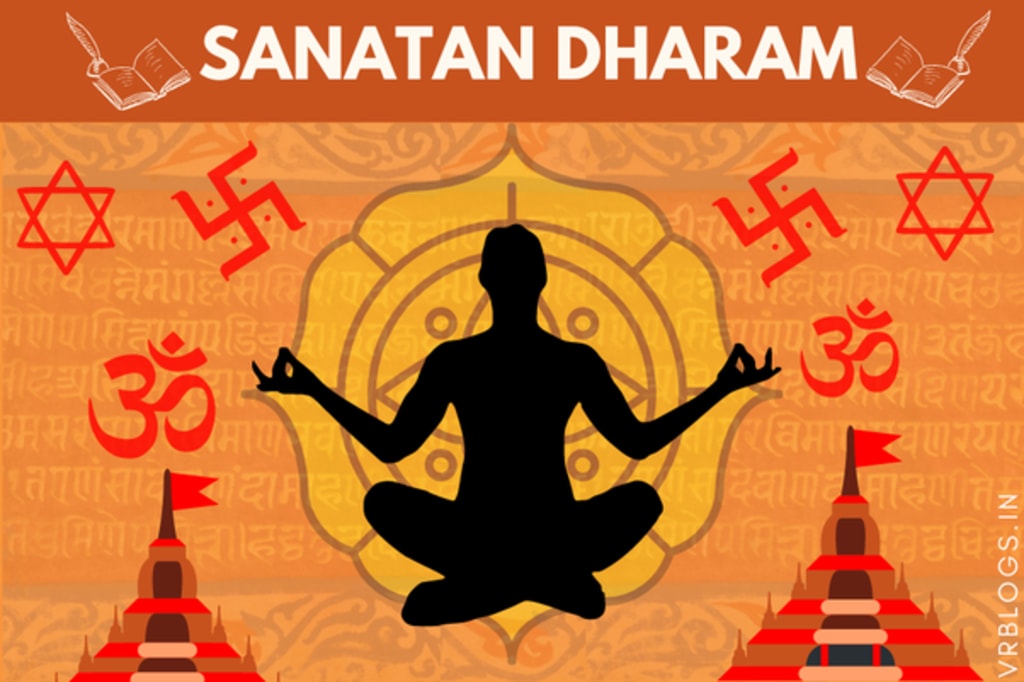Sanatana Dharma: Navigating the Eternal Path of Righteousness
Philosophical Foundations, Cultural Richness, and Contemporary Relevance in the Modern World

Introduction
Sanatana Dharma, often referred to as Hinduism, is not just a religion but a way of life that has evolved over millennia. Rooted in ancient scriptures, philosophical treatises, and a rich tapestry of cultural practices, Sanatana Dharma transcends the boundaries of time and space, emphasizing the eternal principles that govern the universe. In this comprehensive exploration, we will delve into the essence of Sanatana Dharma, its foundational concepts, philosophical underpinnings, and its relevance in the contemporary world.
I. **Etymology and Conceptual Framework**
The term "Sanatana Dharma" is derived from the Sanskrit words "Sanatana," meaning eternal or timeless, and "Dharma," often translated as duty, righteousness, or cosmic order. Therefore, Sanatana Dharma can be understood as the eternal path of righteousness and the universal principles that uphold the order of the cosmos.
Unlike many organized religions, Sanatana Dharma does not have a single founder or a specific set of dogmas. Instead, it encompasses a vast body of scriptures, including the Vedas, Upanishads, Bhagavad Gita, Puranas, and others, which collectively form the philosophical and spiritual foundation of Hinduism.
II. **Core Philosophical Tenets**
Sanatana Dharma is marked by its pluralistic and inclusive nature, accommodating a wide array of beliefs and practices. The core philosophical tenets that form the crux of this ancient tradition include:
1. **Dharma (Righteous Duty):** Central to Sanatana Dharma is the concept of Dharma, which refers to the righteous duty or moral and ethical obligations that individuals must uphold in their respective roles and circumstances. Dharma serves as a guiding principle for harmonious living and the maintenance of cosmic order.
2. **Karma (Law of Cause and Effect):** The principle of Karma is integral to Sanatana Dharma, emphasizing the consequences of one's actions. According to this doctrine, every action, whether physical, mental, or verbal, has repercussions, and individuals are bound by the cycle of cause and effect.
3. **Moksha (Liberation):** Moksha represents the ultimate goal of human life in Sanatana Dharma. It is the liberation from the cycle of birth and death (samsara) and the union of the individual soul (atman) with the universal consciousness (Brahman). Various paths, such as Jnana Yoga (path of knowledge), Bhakti Yoga (path of devotion), Karma Yoga (path of selfless action), and Raja Yoga (path of meditation), are outlined for seekers on the journey towards Moksha.
4. **Cycle of Creation and Dissolution (Srishti and Pralaya):** Sanatana Dharma acknowledges the cyclical nature of the universe, which undergoes periods of creation (Srishti) and dissolution (Pralaya). This cosmic rhythm is governed by the eternal laws (Rita), illustrating the impermanence of the material world.
III. **Diversity and Pluralism**
One of the remarkable aspects of Sanatana Dharma is its ability to embrace diversity and pluralism. The tradition accommodates a multitude of deities, rituals, and paths to spiritual realization. While many other religions promote a singular path to salvation, Sanatana Dharma recognizes that individuals have diverse temperaments and inclinations, and thus, provides various avenues for spiritual growth.
The worship of deities in various forms and manifestations allows adherents to connect with the divine in ways that resonate with their unique spiritual temperament. Whether through the devotion to Vishnu, Shiva, Devi, or other deities, practitioners find a multitude of paths that lead to the same ultimate truth.
IV. **Rituals and Symbolism**
Rituals play a significant role in Sanatana Dharma, serving as a means to express devotion, cultivate discipline, and align individuals with cosmic forces. From daily worship at home (puja) to elaborate ceremonies conducted in temples, rituals are designed to bring individuals closer to the divine and foster a sense of interconnectedness with the cosmos.
Symbolism is intricately woven into these rituals, with each gesture, mantra, and offering carrying profound meanings. For example, the lighting of the lamp during worship symbolizes dispelling ignorance with the light of knowledge, while the circular shape of the traditional Hindu temple represents the cyclical nature of the universe.
V. **Social Order and Dharma in Society**
Sanatana Dharma provides guidelines for an ideal social order, emphasizing the concept of Varna (four social classes) and Ashrama (four stages of life). The four Varnas - Brahmana (priests and scholars), Kshatriya (warriors and rulers), Vaishya (merchants and agriculturists), and Shudra (service providers) - are seen as complementary parts of a harmonious social structure.
Each Varna has its specific duties and responsibilities, collectively contributing to the well-being and balance of society. The Ashrama system outlines the stages of life - Brahmacharya (student), Grihastha (householder), Vanaprastha (retired life), and Sannyasa (renunciation) - guiding individuals through the various phases of their earthly existence.
VI. **Relevance in the Modern World**
As we navigate the complexities of the modern world, the principles of Sanatana Dharma continue to offer valuable insights and guidance. The emphasis on Dharma encourages ethical decision-making in personal and professional life. The concept of Karma reminds individuals to act responsibly, considering the consequences of their actions on both themselves and the broader society.
The paths of yoga outlined in Sanatana Dharma, including physical postures (asanas), breath control (pranayama), and meditation, have gained global recognition for promoting physical and mental well-being. The universal appeal of these practices transcends cultural and religious boundaries, resonating with individuals seeking holistic approaches to health and self-realization.
Furthermore, the inclusive nature of Sanatana Dharma fosters respect for diverse beliefs and encourages a spirit of coexistence. In a world marked by religious and cultural pluralism, the ancient wisdom of Sanatana Dharma provides a foundation for fostering tolerance, understanding, and harmony among different communities.
Conclusion
Sanatana Dharma stands as a timeless beacon of wisdom, offering a holistic framework for navigating the intricacies of human existence. Its philosophical depth, spiritual insights, and cultural richness continue to inspire millions around the world. In embracing the eternal principles of righteousness, individuals find a path that transcends the limitations of time and space, leading towards self-realization and the ultimate goal of Moksha. As we reflect on the profound teachings of Sanatana Dharma, we recognize the enduring relevance of this ancient tradition in guiding humanity towards a harmonious and purposeful life.
About the Creator
Harika Vaddi
Exploring various topics through writing.





Comments
There are no comments for this story
Be the first to respond and start the conversation.